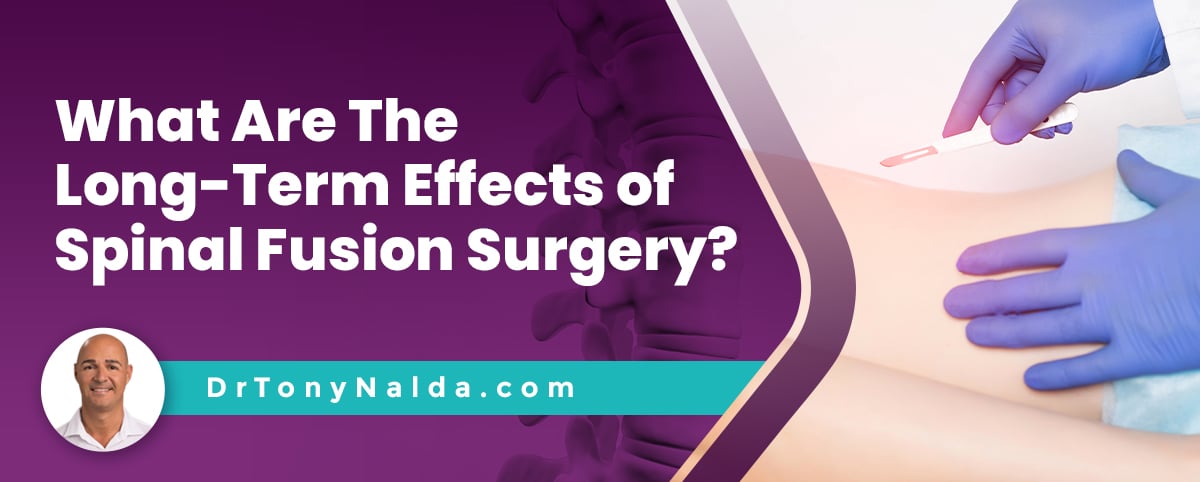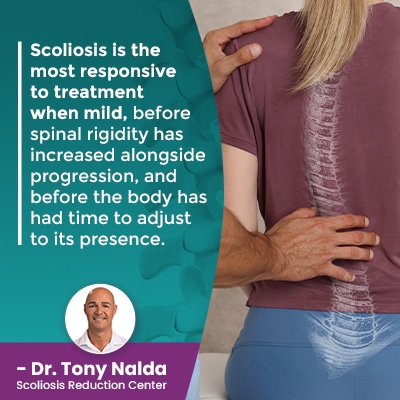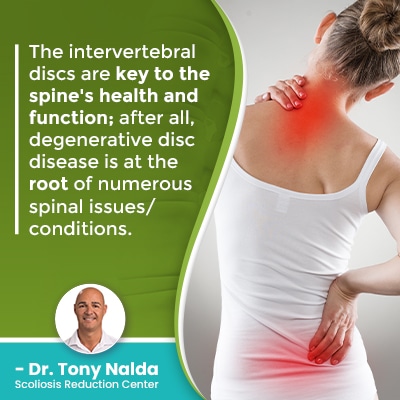What Are The Long-Term Effects of Spinal Fusion Surgery?

There is more than one way to treat scoliosis, and different approaches offer different potential outcomes. I want patients to be aware of all options available to them, rather than being funneled towards invasive surgery; the reality is that most cases of scoliosis can be treated non-surgically.
While a patient's response to surgical procedures is based on a number of variables, there are some potential long-term side effects of spinal fusion surgery that should be considered carefully, including a loss of spinal flexibility and range of motion.
To start our discussion of scoliosis surgery effects, let's start with defining the condition itself and move on to the potential side effects of spinal fusion surgery.
Table of Contents
Defining Scoliosis
Being diagnosed with scoliosis means an unnatural sideways spinal curve has developed, with a rotational component, meaning the spine also twists from front to back, back to front; this is what makes scoliosis a 3-dimensional condition.
An unnatural spinal curve also has to have a minimum Cobb angle measurement of 10 degrees, and Cobb angle is an important condition feature that classifies conditions in terms of severity:
- Mild scoliosis: Cobb angle measurement of between 10 and 25 degrees
- Moderate scoliosis: Cobb angle measurement of between 25 and 40 degrees
- Severe scoliosis: Cobb angle measurement of 40+ degrees
- Very-severe scoliosis: Cobb angle measurement of 80+ degrees
While there are other classification points - patient age, condition type, and curvature location - in the context of spinal fusion, severity is key because it's when a condition progresses into the severe classification that traditional treatment often recommends spinal fusion surgery.
Scoliosis is Progressive
Perhaps the most important condition feature to understand is that as a progressive condition, scoliosis has it in its very nature to worsen over time, particularly if left untreated, or not treated proactively.
So where a condition is at the time of diagnosis is not indicative of where it will stay. Even scoliosis diagnosed as mild can easily progress to moderate, severe, and very severe; only proactive treatment can counteract the condition's progressive nature.
Spinal instability can cause a lot of issues felt throughout the body, and there are different ways to approach improving spinal instability, both surgically and non-surgically.
This is why being proactive with scoliosis is so beneficial: because it means starting treatment while the condition is at its mildest, when there are fewer limits to what we can achieve.
However, how a condition is responded to at the time of diagnosis will vary based on the treatment approach a patient has committed to, meaning the potential results will also vary.
Let's now address the characteristics of the two main treatment approaches: traditional and conservative.
Traditional Scoliosis Treatment
Traditional treatment was the dominant choice for many years, and this is why I want patients to know that that's no longer the case.
Traditional scoliosis treatment is more reactive than proactive, and this is because of the way it responds to the condition's different severity levels.
The reality is that traditional treatment doesn't have a strategy for addressing scoliosis while mild, so it responds with watching and waiting, to see if a patient's mild scoliosis progresses; the issue I have with this is that as a progressive condition, we know it's going to progress at some point, so why waste valuable treatment time?
 Scoliosis is the most responsive to treatment when mild, before spinal rigidity has increased alongside progression, and before the body has had time to adjust to its presence.
Scoliosis is the most responsive to treatment when mild, before spinal rigidity has increased alongside progression, and before the body has had time to adjust to its presence.
Traditional treatment commonly recommends returning for periodic assessments every 3, 6, or even 12 months (intervals vary based on the treatment provider).
In the condition's most-prevalent form, adolescent idiopathic scoliosis (AIS), we don't fully understand its etiology, but we do know how to treat it effectively, and we do know what triggers its progression: growth and development.
So what happens if, during one of these assessment intervals, an adolescent with mild scoliosis has a significant growth spurt?
What can happen is it can make the condition progress quickly; in fact, this age group is at risk for rapid-phase progression, which is why being proactive is so important.
Let's now address the specifics of spinal fusion surgery.
Spinal Fusion Surgery
So if a patient, on the traditional path of treatment, progresses past the surgical-level threshold at 40+ degrees, and shows signs of continued progression, they become a surgical candidate and commonly receive a surgical recommendation.
While there are different types of spinal fusion surgery, most often, the process involves fusing the most-tilted vertebrae, at the curve's apex, into one solid bone; this can involve two vertebrae, or more, and the removal of the spine's intervertebral discs in between the vertebrae.
The intervertebral discs are key to the spine's health and function; after all, degenerative disc disease is at the root of numerous spinal issues/conditions.
Instrumented fusion means rods are attached to the spine with screws to hold it in place, and while, when successful, spinal fusion can make a crooked spine straighter, this is not the same as achieving corrective results through more natural treatment.
The theory behind fusing the curve's most-tilted vertebrae into one solid bone is that it eliminates movement in the area (progression), meaning the vertebrae won't become more tilted, and the curve will no longer progress.
While any bone joint surgery comes with its share of risks, spinal fusion surgery is an invasive procedure that carries some serious potential side effects, risks, and complications.
A big concern I have with spinal fusion is its long-term effects, and the reality is that there is a large gap in the data/research on these effects 20, 30, 40+ years down the road, but let's address some of the effects we've seen, in addition to risks associated with the procedure itself.
Risks Associated with Spinal Fusion Surgery
In addition to the long term side effects of spine surgery, there are also the risks and complications associated with the procedure itself.
As mentioned, there are different types of spinal fusion, so we're focusing on the prevalent type involving rods attached to the spine with screws, and when we're talking about putting any foreign object inside the body that's permanent, as fusion hardware is, there are a number of risks involved.
While surgeons have their patients' best interests at heart, following are some common risks associated with the procedure itself:
- Nerve damage
- Excessive blood loss
- Infection
- Pain at the fusion site
- Adverse reaction to hardware used
The aforementioned risks are not going to affect every patient; there are a number of varying contributing factors such as patient age and overall health, condition severity, curvature location (cervical, thoracic, or lumbar spinal fusion), and the number of vertebrae fused (length of the fused segment).
Particularly for patients who have had lumbar spinal fusion, as the lumbar spine feels the effects of lifting, bending, and twisting motions, complications can be high.
One level lumbar fusion surgery is not as risky as when fusion involves more than one of the spine's motion segments, so with one fusion, the risk of losing a noticeable degree of spinal flexibility is reduced.
Long-Term Effects Post-Surgery
Now, when we're talking about the long term side effects of spine surgery, we're talking about what it's like to live and age with a fused spine, and there are a number of effects that patients need to be aware of, as they can affect quality of life:
- Nerve damage
- Back pain
- Adverse reaction to hardware over time
- Hardware failure
- Strained spinal muscles (muscle pain)
- A spine that's weaker and more vulnerable to injury
- Psychological effects of spinal fusion surgery
- Loss of spinal flexibility and range of motion
- Disappointing cosmetic results
As the brain and spinal cord work in tandem to form the body's central nervous system, any spine surgery comes with the risk of nerve damage.
Severe pain can actually increase in patients who have had spinal fusion, and this is because a fused spine isn't natural, and a spine held in place artificially is likely to involve some level of discomfort.
Additional Surgeries Increase Risk
One of the gaps in the long term side effects of spinal fusion that I'm referring to is how long the hardware can last because if it degrades, cracks, or breaks down at some point, the only recourse is additional surgeries being performed, and facing those risks all over again.
Also, surgery risks increase with age, and when it comes to hardware failure, keep in mind that the younger the patient is, the longer that hardware has to last, and the reality is that, while not particularly common, screws can come loose, and rods can deteriorate.
It's not just the spine that maintains its natural curves and alignment, it's also its surrounding muscles, so when a portion of the spine is fused, it can make the surrounding muscles stiff and sore and more vulnerable to spinal muscle injury.
Spines that have been fused are not as strong because their natural function has been affected, and this makes them more vulnerable to injury.
The psychological effect of knowing the spine is weaker and more prone to injury can cause patients anxiety and make them fearful of trying new things and/or participating in once-loved activities.
The number-one reason patients opt for spinal fusion is cosmetic; they feel that surgery is the best way to restore their pre-scoliosis bodies (scoliosis disrupts the body's overall symmetry), improving the spinal deformity, but this isn't always the case.
As posterior fusion focuses on the spine, some of the condition's postural effects can't be completely reversed, particularly in the hips.
Loss of Spinal Function
Loss of spinal flexibility and range of motion is one of the most common, if not the most common, known long-term effect, and this is because there is no movement in the spine's fused section.
 The very design of the spine is based on movement, so a spine that's held artificially in place is not going to move and bend the same way, and removal of the intervertebral discs is also contrary to the spine's natural function and design.
The very design of the spine is based on movement, so a spine that's held artificially in place is not going to move and bend the same way, and removal of the intervertebral discs is also contrary to the spine's natural function and design.
While some patients have enough flexibility in the sections above and below the fused section, posterior fusion involves fusing two or more vertebrae, and many patients experience a significant loss that affects quality of life.
Many patients are also disappointed with how their back pain persists post-surgery.
Conclusion
While there is still a place for spinal fusion surgeries in scoliosis treatment, and when successful, it can make a crooked spine straighter, for some, it can come with some serious long-term effects; fused segments of the spine tend to be painful and less flexible.
What I want patients to fully understand is that most cases of scoliosis can be treated non-surgically, and here at the Scoliosis Reduction Center, I provide patients with a more natural and less-invasive form of treatment.
In addition, a conservative chiropractic-centered treatment approach has proven results that can promote healing and don't cost the spine in terms of its overall strength and function, as spine surgery is associated with.
Alternative treatments offered here at the Center are condition-specific and include chiropractic care, in-office therapy, corrective bracing, and custom-prescribed home exercises.
So for those who choose to forgo a surgical recommendation, or want to try a less-invasive treatment option first, and not face the possibility of additional surgeries, there is a non-surgical treatment option that aims to preserve as much of the spine's natural function and strength as possible.
Dr. Tony Nalda
DOCTOR OF CHIROPRACTIC
After receiving an undergraduate degree in psychology and his Doctorate of Chiropractic from Life University, Dr. Nalda settled in Celebration, Florida and proceeded to build one of Central Florida’s most successful chiropractic clinics.
His experience with patients suffering from scoliosis, and the confusion and frustration they faced, led him to seek a specialty in scoliosis care. In 2006 he completed his Intensive Care Certification from CLEAR Institute, a leading scoliosis educational and certification center.
About Dr. Tony Nalda
 Ready to explore scoliosis treatment? Contact Us Now
Ready to explore scoliosis treatment? Contact Us Now





